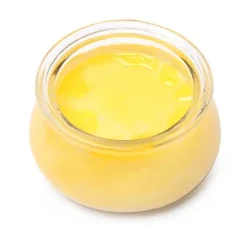IUPAC Name
Hexadecanoic Acid
Cas Number
1340-00-7
HS Code
0405.90.10
Formula
CnH2nO
Industry
Food Ingredients
Appearance
Yellow semi solid
Common Names
Clarified Butter
Packaging
Barrel 190 kg
Brief Overview
Butter oil, also known as clarified butter, is a dairy product prepared by heating milk, cream or butter over 100 °C to evaporate water and precipitate the nonfat solids. Butter oil is a lipophilic product with 99 - 99.5% lipids, from which 46 - 47.8% is saturated fat, 36% monounsaturated and 18% polyunsaturated. Butter oil is a good source of lipophilic vitamins, especially vitamins A and E, and conjugated linoleic acid – CLA. This is a ruminant trans fatty acid (rTFA) that has give health benefits, both in vitro and in vivo, such as anti-obesity, anti-carcinogenic, anti-atherogenic, anti-diabetic, anti-mutagenic, anti-hypertensive, immunomodulatory, apoptotic and osteosynthetic.
Manufacturing Process
Butter oil is produced by melting butter and separating the components by density. The water evaporates, and some solids (i.e. awhey proteins) float to the surface and are skimmed off. The remainder of the milk solids (casein) sink to the bottom and are left behind when the butterfat (which would then be on top) is poured off or separated with a separatory funnel or a gravy fat separator. This butterfat is clarified butter. Commercial methods of production also include direct evaporation, but may also be done by decantation and centrifugation followed by vacuum drying or direct from cream by breaking the emulsion followed by centrifugation.
Food Industry
Butter oil is usually used to produce recombined milk for reconstitution into butter. It can be used in the manufacture of ice cream, as a cooking medium and in the confectionery industry. Butter oil is also used in the production of various types of fat spreads.
